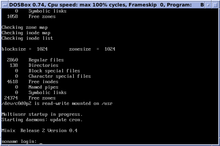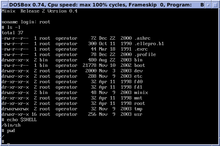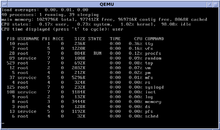Minix
 | |
 The MINIX 3.3.0 login prompt | |
| Developer | Andrew S. Tanenbaum, et al. |
|---|---|
| Written in | C |
| OS family | Unix-like |
| Working state | Abandoned |
| Source model | Open-source |
| Initial release | 1987 |
| Latest release | 3.3.0[1] / 16 September 2014 |
| Latest preview | 3.4.0rc6[2] / 9 May 2017 |
| Repository | |
| Marketing target | BSD (NetBSD) |
| License | 2005: BSD-3-Clause[a][4] 2000: BSD-3-Clause[5][6][7] 1995: Proprietary[8] 1987: Proprietary[9] |
| Official website | www |
MINIX (from mini-Unix) is a Unix-like operating system based on a microkernel architecture. Since version 2.0, it has been Portable Operating System Interface (POSIX) compliant.[10][11]
Early versions of MINIX were created by
MINIX was first released in 1987, with its complete source code made available to universities for study in courses and research. It has been free and open-source software since it was relicensed under the BSD-3-Clause license in April 2000.[6]
Implementation
MINIX 1.0
An abridged 12,010 lines of the
Tanenbaum originally developed MINIX for compatibility with the
MINIX 1.5
MINIX 1.5, released in 1991, included support for
MINIX 2.0


Demand for the 68k-architectures waned, however, and MINIX 2.0, released in 1997, was only available for the
Version 2.0.3 was released in May 2001. It was the first version after MINIX had been relicensed under the BSD-3-Clause license, which was retroactively applied to all previous versions.[17]
Minix-vmd
Minix-vmd is a variant of MINIX 2.0 for Intel IA-32-compatible processors, created by two Vrije Universiteit researchers, which adds virtual memory and support for the X Window System.
MINIX 3


MINIX 3 was publicly announced on 24 October 2005 by Tanenbaum during his keynote speech at the Association for Computing Machinery (ACM) Symposium on Operating Systems Principles (SOSP). Although it still serves as an example for the new edition of Tanenbaum's textbook, coauthored by Albert S. Woodhull, it is comprehensively redesigned to be "usable as a serious system on resource-limited and embedded computers and for applications requiring high reliability."[18]
MINIX 3 currently supports
Version 3.1.2 was released on 18 April 2006. It was the first version after MINIX had been relicensed under the BSD-3-Clause license with a new fourth clause.[19]
Version 3.1.5 was released on 5 November 2009. It contains
As of version 3.2.0, the
MINIX 3.3.0, released in September 2014, brought ARM support.
MINIX 3.4.0RC, Release Candidates became available in January 2016.[23] However, a stable release of MINIX 3.4.0 is yet to be announced, and MINIX development has been dormant since 2018.[24]
MINIX supports many programming languages, including
.Over 50 people attended MINIXCon 2016, a conference to discuss the history and future of MINIX.[25]
All Intel chipsets post-2015 are running MINIX 3 internally as the software component of the Intel Management Engine.[26][27]
Relationship with Linux
Early influence
Linus Torvalds used and appreciated MINIX,[28] but his design deviated from the MINIX architecture in significant ways, most notably by employing a monolithic kernel instead of a microkernel. This was disapproved of by Tanenbaum in the Tanenbaum–Torvalds debate. Tanenbaum explained again his rationale for using a microkernel in May 2006.[29]
Early
Samizdat claims
In May 2004,
Licensing
At the time of MINIX's original development, its license was relatively liberal. Its licensing fee was very small ($69) relative to those of other operating systems. Tanenbaum wished for MINIX to be as accessible as possible to students, but his publisher was unwilling to offer material (such as the source code) that could be copied freely, so a restrictive license requiring a nominal fee (included in the price of Tanenbaum's book) was applied as a compromise. This prevented the use of MINIX as the basis for a freely distributed software system.
When
See also
- MINIX file system
- Redox, an operating system in Rust using a MINIX-like kernel
- Xinu
- xv6
Notes
- ^ BSD-3-Clause with a fourth clause.
References
- ^ Michael Larabel (16 September 2014). "Minix 3.3 Released With Cortex-A8 ARM Support, NetBSD Userland Compatibility". Phoronix.
- ^ MINIX 3.4 RC6 Released - Phoronix
- ^ "Intel ME: The Way of Static Analysis". Archived from the original on 1 July 2017. Retrieved 4 July 2017.
- ^ a b "The MINIX license". Archived from the original on 24 November 2005. Retrieved 24 November 2005.
- ^ "MINIX license change". Archived from the original on 6 December 2022. Retrieved 23 December 2023.
- ^ a b "MINIX is now available under the BSD license". Archived from the original on 8 May 2006. Retrieved 14 June 2021.
- ^ a b "Minix". Archived from the original on 13 October 2006. Retrieved 15 June 2021.
The Minix license changed in April 2000, and applies retroactively to all previous Minix distributions, even though they still carry the old, more restrictive license within.
- ^ "License (1.7.0 to 2.0.2)". Archived from the original on 26 July 1997. Retrieved 14 June 2021.
- ^ "Minix versions and their use in teaching". Archived from the original on 11 July 2006. Retrieved 14 June 2021.
- ^ a b Tanenbaum, Andrew S. (20 May 2004). "Some Notes on the "Who wrote Linux" Kerfuffle, Release 1.5". Archived from the original on 18 August 2010. Retrieved 20 August 2016.
- ^ a b Tanenbaum, Andrew S.; Woodhull, Albert S.; Sambuc, Lionel (11 March 2015). "MINIX 3 FAQ". Archived from the original on 26 April 2019. Retrieved 20 August 2016.
- ^ "MINIX advertisement". Computerworld. Vol. 13, no. 31. 30 July 1979. p. 38. Retrieved 22 March 2022.
- OCLC 35792209. Retrieved 2 August 2011.
- ^ "MacMinix". GitHub.
- ^ Tanenbaum, Andrew S.; Woodhull, Albert S.; Bot, Kees (22 July 2005). "Welcome to MINIX" (TXT). Retrieved 2 August 2011.
- ^ Flouris, M. "Installing and running MINIX for Solaris (SMX)". Archived from the original on 12 May 2016. Retrieved 2 August 2011.
- ^ a b "BSD-3-Clause". Archived from the original on 14 April 2000. Retrieved 14 June 2021.
- S2CID 30216714.
- ^ "License". GitHub. Archived from the original on 15 June 2021. Retrieved 15 June 2021.
- ^ Schmidt, Ulrich (10 November 2010). "New to minix". Retrieved 2 August 2011.
- ^ "MINIX Releases". wiki.minix3.org. Archived from the original on 31 May 2012. Retrieved 29 February 2012.
- lwn.net.
- ^ "Index of /iso/snapshot/". download.minix3.org. Retrieved 14 October 2016.
- ^ "git.minix3.org Git - minix.git/summary". git.minix3.org. Retrieved 23 September 2022.
- ^ "MINIXCon 2016". www.minix3.org. Retrieved 14 October 2016.
- ^ "Positive Technologies research". blog.ptsecurity.com. Archived from the original on 28 August 2017. Retrieved 6 September 2017.
- ^ Vaughan-Nichols, Steven (6 November 2017). "MINIX: Intel's hidden in-chip operating system". ZDNET.
- ^ Moody, Glyn (25 August 2015). "How Linux was born, as told by Linus Torvalds himself". Ars Technica. Retrieved 25 August 2015.
- ^ Tanenbaum, Andrew S. (12 May 2006). "Tanenbaum-Torvalds Debate: Part II". Retrieved 2 August 2011.
- ISBN 1-56592-724-9.
- Brown, Kenneth (4 June 2004). "Samizdat's critics… Brown replies". Alexis de Tocqueville Institution. Archived from the originalon 22 October 2004. Retrieved 2 August 2011.
